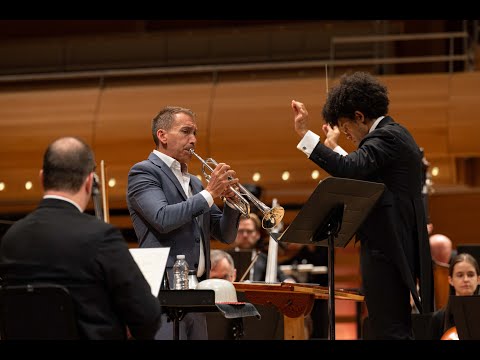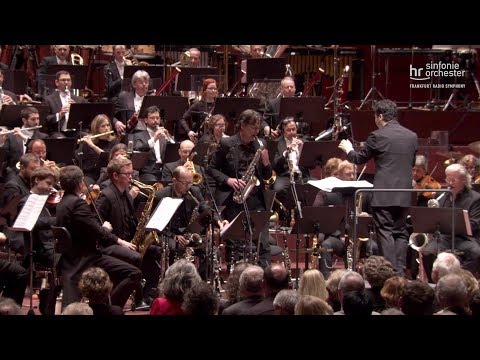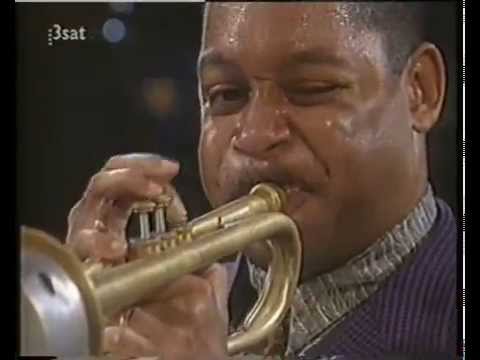In 1998, The New Yorker jazz critic Whitney Balliett predicted with remarkable prescience the future creations of Wynton Marsalis. Following “Blood on the Fields,” Marsalis’s jazz oratorio which, to Balliett’s surprise, won a Pulitzer Prize for Music that year, he wondered what might be next for the trumpeter and composer: “Perhaps Marsalis will write a jazz opera, a jazz symphony, a concerto for jazz trumpet.”
Though a jazz opera never came to fruition—the Met commissioned one from him in 2006 that never materialized—three jazz symphonies did (“All Rise,” “Blues Symphony,” and 2010’s “Swing Symphony”). And now, at long last, he has written his concerto for jazz trumpet; or, as Alison Balsom put it ahead of her UK premiere of the piece in April, a trumpet concerto “with more jazzy movements.”
Co-commissioned by the Cleveland Orchestra, the Verbier Festival and the London Symphony Orchestra, the piece came from a conversation with Marsalis’s friend, the Cleveland principal trumpet Michael Sachs, who premiered it in 2023. And, like most modern-day international co-commissions, a lot rides on its ability to take flight immediately. After Cleveland, it was heard in Sweden and Montreal, before receiving its UK premiere in April, and being performed twice more; once at the Bristol Beacon, and again last week at the Edinburgh Festival.
The concerto is cast in the classically Marsalis form of a history lesson. “Our instrument went through many evolutions,” Marsalis wrote in the original Cleveland program note, “and the concerto tries to deal with that legacy.” It follows a loosely chronological through line over six movements and 35 minutes. Commentators have described it variously as an anthology, a history and an encyclopedia of the trumpet.
It’s not the first time that Marsalis has used an extended concert hall work to tell an ambitious story about the history of music. The “Swing Symphony,” a sprawling, hour-long piece—and another international co-commission, from Berlin Philharmonic, the London Symphony Orchestra, the New York Philharmonic, and the Los Angeles Philharmonic—put forward the particular story of jazz which Marsalis has dedicated his career to telling. In its survey of the evolution of swing, from ragtime through New Orleans parades, Kansas City swing, Charleston, bebop, mambo, and then something in the score marked “modern primal” (involving collective improvising over modal jazz forms reminiscent of early Coltrane and Davis), the lesson of “Swing Symphony” was as much in what it left out as what it put in.
Though Marsalis called the piece a “symphonic meditation,” it functions more like an aural manifestation of Marsalis’s long-held philosophy. Marsalis’s aural history of swing stops at the point where he believes jazz lost its way: when free jazz broke with its blues roots, and when straight-ahead jazz fused with genres like funk and pop and entered the marketplace. Though it’s hard not to find joy in the “Swing Symphony”—written for jazz orchestra and symphony orchestra combined, it’s a spectacular piece in the most literal sense—the historicizing is clear as day, as are its moralizing implications: that the only way to solve the decay caused by straying from the true path is to revisit its roots, for the form to rediscover its integrity. (The writer Philip Clark described “Swing Symphony” as “a structure claiming to embody the entire history of jazz, held together only by hubris.”)
The trumpet concerto is half as long as the “Swing Symphony,” but is intent on telling its own historical stories regardless. “I always tell a joke that the trumpet is in the Bible,” Marsalis notes. “The archangel Gabriel played the trumpet and the world started, and then, in the end, the trumpet will sound. It’s beginning the world and ending the world.” After an “elephant” opening—as well as representing some loose animal primordialness, the gesture is now lumbered with representing the literal beginning of the world—the work travels through Haydn pastiches to Louis Armstrong (“who made the trumpet actually sound like a human being,” Marsalis notes), then through figures associated with the French school of technical trumpet mastery (and the concertos by Tomasi and Jolivet that their world produced), stopping off at a virtuoso circus-y mute-juggling act, and ending with fiendishly difficult flourishes. Alpha and omega, an instrument’s technological evolution, and the evolution of animal to human to virtuosic master… What was it that Clark said about hubris?
At least with the overlong “Swing Symphony,” there was an attempt to tell a comprehensive story, however musically reductive or morally charged it that might be. The trumpet concerto seems to apologize to the world-historical schemes it outlines, content instead to provide edited highlights of a history padded out by technical virtuosity.
As with all historical surveys, what’s left out says the most about the author. We shouldn’t be surprised that a historical overview given by one of America’s most prominent conservative musical voices—one whose career has been dedicated to the preservation and memorialization of a particularly limited idea of what jazz is—is also content to stop his survey of the trumpet at the point of yesteryear, rather than yesterday. The piece concludes, musically and historically, with virtuosity—given the roll-call of male trumpet players from history that Marsalis and Sachs pay homage to, it’s a particularly gendered form of virtuosity—and we’re left with the implication that Marsalis feels virtuosity is the true telos of trumpet playing. (There are more than a few alternative trumpet concertos that imply such ideas are bollocks.)
But there’s something else happening in the concerto. “The piece’s patchwork structure was hard to grasp and Marsalis’s own voice even harder to detect,” Richard Morrison wrote in his review for The Times. Is jazz’s arch polemicist running out of things to say?
It’s strange to read that Marsalis’s voice has become harder to detect, because the jazz world has become accustomed to hearing his voice loud and clear for a very long time. From his bully pulpit at the top of Jazz at Lincoln Center, Marsalis has steadfastly defended his right to consolidate what he would refer to as “America’s classical music” that stopped somewhere around Ornette Coleman.
Ken Burns’s 2001 PBS series “Jazz” laid bare the problems with that approach. Marsalis served as one of its co-producers, and with influential allies Stanley Crouch and Albert Murray on board as commentators, the landmark series skewed heavily towards jazz as a historical form. Of the ten episodes, nine surveyed the period 1917 to 1961, with only the final episode left to discuss the 50 years after that. In a review titled “Jazz: The Obituary,” UK jazz critic Richard Williams said the documentary “resembles nothing so much as a jam session in a mausoleum.”
There’s a tendency to suggest that this stuff is all in the past, and that the “jazz wars” over the direction of its future have ceased to exist as a concern in an ecumenical streaming age. Marsalis has undoubtedly softened, and the Jazz at Lincoln Center narrative has gradually diversified, but some things have proven too offensive to him to let go, the most famous being his vicious aversion to hip-hop. “I don’t have to attack hip-hop. Hip-hop attacks itself. It has no merit, rhythmically, musically, lyrically,” he told John Lewis in 2007. But it goes much further and deeper than an aesthetic concern. “Hip-hop for me is a throwback to the minstrelsy,” he noted in 2012. (“A ghetto minstrelsy,” hip-hop “substitutes the plantation for the streets,” Marsalis had previously claimed.) In 2018, Marsalis stirred controversy by suggesting that hip-hop was more damaging to Black people than a statue of Robert E. Lee. It all circles back to a worldview shaped by respectability politics, his mentors Crouch and Murray (he name checks in the lecture), and a deep, longstanding commitment to his artform’s history, but at what point does an aesthetic concern veer into a reactionary, close-minded politics?
The answer is, well, right about now. ”One could drive a bus through some of the holes in Marsalis’s arguments,” Lewis wrote at the time. The same is true today. “A Life in Jazz: An Education in Integrity” is the typically Wyntonish title of a lecture given by Marsalis at the Netherlands’ Nexus Institute last year, and is available to read online. It’s a fascinating document, a declaration of the power of community and the necessity of civilization undercut by a steady stream of reactionary nonsense, sprinkled with bits of jazz history. “We need a revolution in vision,” he opens. “Never has there been a time so out of touch with hardship as a basic fact of life,” channeling every boomer dad asking their kids to do chores. “Charlie Parker said: ‘If you don’t live it, it won’t come out of your horn.’ He was talking about mining the depths of human feeling, not lauding the cheap thrills of your favorite vices.” Reclaiming Charlie Parker as an anti-drugs ambassador is a bold move, even for Wynton.
The latest from VAN, delivered straight to your inbox
In a revealing passage, the slide from aesthetics to polemic to reactionary rhetoric seems to occur in real time. “Through the first eight decades of the twentieth century, jazz produced the longest index of brilliant musicians the world has ever seen,” Marsalis states in typically effusive style. Then, in the 1980s, jazz’s objectives quickly shifted:
From a group of people balancing volume and intention to a group of individuals asking for more of themselves in an onstage monitor mix; from infinite swinging and grooving possibilities to one or two repetitive backbeat inflected rhythms; from coherent extended melodic solos to strings of overemotive phrases with appropriate ‘into it’ faces for effect; from a tradition of innovation based on musical study and discovery, to the innovation of violation like the first legal gambling site connected to a sporting league housed in a college, the first doctors to successfully addict their patients to legal drugs, the first bankers to cunningly sell the empty future of faulty assets to their trusted international colleagues while also bankrupting their own company, on and on, you know…
Marsalis is enjoying a lot of airtime in the UK at the moment. On top of his Trumpet Concerto, his overture “Herald, Holler and Hallelujah!” opened the Sinfonia of London Prom, while his Violin Concerto, written for Nicola Benedetti in 2015, has quickly become one of the most regularly performed new works of recent years.
Where Marsalis trumpets that “jazz is America’s classical music,” jazz is not the UK’s classical music.
There is a long, storied, rich, interesting, but ultimately contrasting story of the artform on these isles to be told, one of Janine Irons and Gary Crosby, Kenny Wheeler and Norma Winstone, Tubby Hayes, Courtney Pine, Soweto Kinch and John Dankworth. Though the essential roots of the form are the same, the UK has never had the same infrastructure of clubs and performances, nor the same wrap-around education, nor the institutionalization of the form that has allowed jazz in the United States to develop and consolidate. When it comes to artistic developments in the concert hall, the UK also lacks both the kind of Gunther Schuller legacy of “Third Stream” and the government funding that has made centers of jazz activity in Norway, Germany, and Denmark. And though a large amount of the resurgence of the genre in the UK in the past decade has stemmed from a revivalist impulse, most (though not all) of the main conclusions—that the roots of the current UK jazz scene have as much to do with reggae, grime, soca and soundsystem culture as they do bebop and the blues—have been reached far away from classical hubs.
The result is that when one man enters the concert hall speaking a familiar language—of civilization, integrity, respect for tradition, and communal experiences—and claiming to tell the story of jazz, we lack the structures to push back, question it, or offer an alternative. We’re more likely to take it as gospel.
So it proved with the most recent concerto, which brought out some of the most patronizing, exoticizing tendencies that the UK classical music scene has towards jazz. “This is the most important piece written for the trumpet in 200 years,” Balsom declared in the Guardian. It’s “incredibly intellectually sophisticated,” she continued on Radio 4. (“This is a man who is not only one of the world’s greatest jazz musicians, but here’s a man who spent his life studying Beethoven as well,” she added.)
Balsom usually plays a C trumpet, but the concerto requires her to play a B-flat instrument too. Switching trumpets for the “jazzier movements,” Balsom described “the added breadth of sound, and a darkness that I feel that I hear in Marsalis’s playing, and in jazz.”
Marsalis has been an endlessly debated figure in American music, and rightly so: he is a man who holds an extraordinary amount of power, previously unheard of in an artform that’s barely 100 years old. But his presence in UK classical music seems a foregone conclusion: new work in a jazz idiom for large orchestra in the UK is Wynton Marsalis, and if you don’t like it, “hardship is a fact of life.” If we are going to have to settle for more partisan-history-pastiche-Bartók-virtuosity, might we at least agree that it’s a gesture that comes with a bit of baggage? ¶
Subscribers keep VAN running!
VAN is proud to be an independent classical music magazine thanks to our subscribers. For just over 10 cents a day, you can enjoy unlimited access to over 875 articles in our archives—and get new ones delivered straight to your inbox each week.
Not ready to commit to a full year?
You can test-drive VAN for one month for the price of a coffee.






